Innovative Chicken House Ideas: From DIY Designs to Simple Building Plans for Your Backyard Flock
A Home Worth Clucking Over
Raising chickens in your backyard is more than just a hobby; it’s a way to enjoy fresh eggs, reduce food waste, and connect with nature. But creating a well-designed chicken house is the first step to keeping your feathered friends happy, safe, and productive. Let’s explore creative, cost-effective, and practical ideas to inspire your next backyard project.
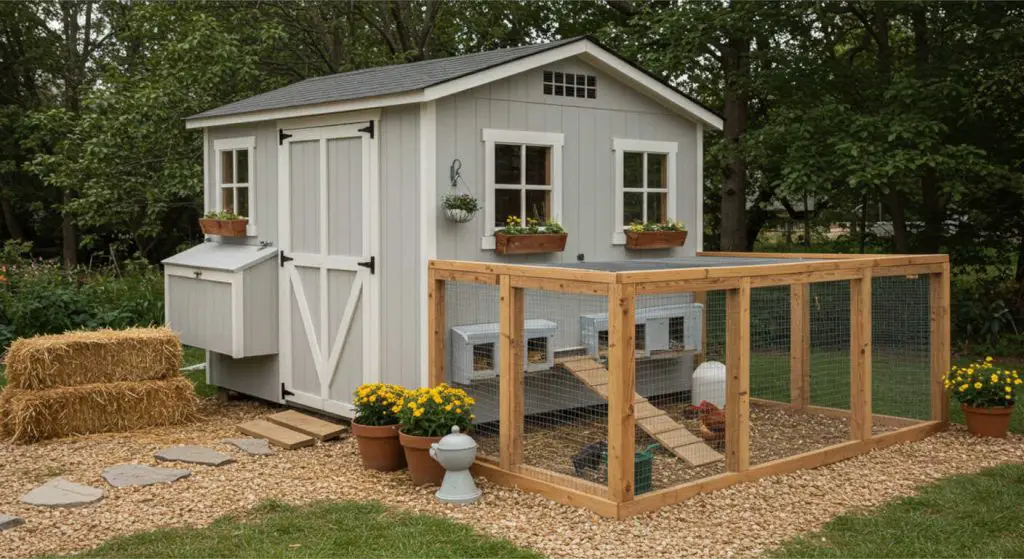
A thoughtfully crafted chicken house plays a critical role in the health, safety, and productivity of your flock. A good coop protects chickens from predators, harsh weather, and disease while providing the ideal environment for egg production and daily activities.
The growing trend of backyard poultry keeping has encouraged many homesteaders and urban dwellers to embrace creative coop designs. Whether you’re an experienced builder or a first-time chicken owner, there’s a chicken house idea to suit every budget, style, and skill level. From DIY projects using upcycled furniture to converting sheds into coops, the possibilities are endless.
Below, we will guide you through innovative ideas, practical tips, and step-by-step plans to help you build a perfect home for your backyard flock.Why a Good Chicken House Matters
Health and Safety
A sturdy chicken house shields your flock from predators like raccoons, foxes, and hawks, ensuring their safety day and night. Proper construction also protects against extreme weather, keeping your birds warm in winter and cool in summer. A clean, enclosed space helps reduce the risk of diseases caused by exposure to contaminated soil or overcrowding.
Egg Production
Comfortable chickens are productive chickens. A well-designed coop with proper ventilation, nesting boxes, and roosting bars encourages hens to lay regularly. Stress from overcrowding or unsafe conditions can lead to fewer eggs or unhealthy birds.
Space Requirements
Chickens need room to roam and roost. A general rule of thumb is 2-3 square feet of indoor space per chicken and 8-10 square feet of outdoor run space. Adequate ventilation prevents ammonia buildup, while insulation helps regulate temperature. Light is also essential for egg production, so consider adding windows or solar lighting.
Chicken House Ideas: Buildings and Repurposed Structures
Repurposed Sheds
Turn an old shed into a functional chicken coop with minimal effort. Add ventilation, nesting boxes, and roosting bars to create a cozy, predator-proof space. A fresh coat of paint can make it visually appealing.
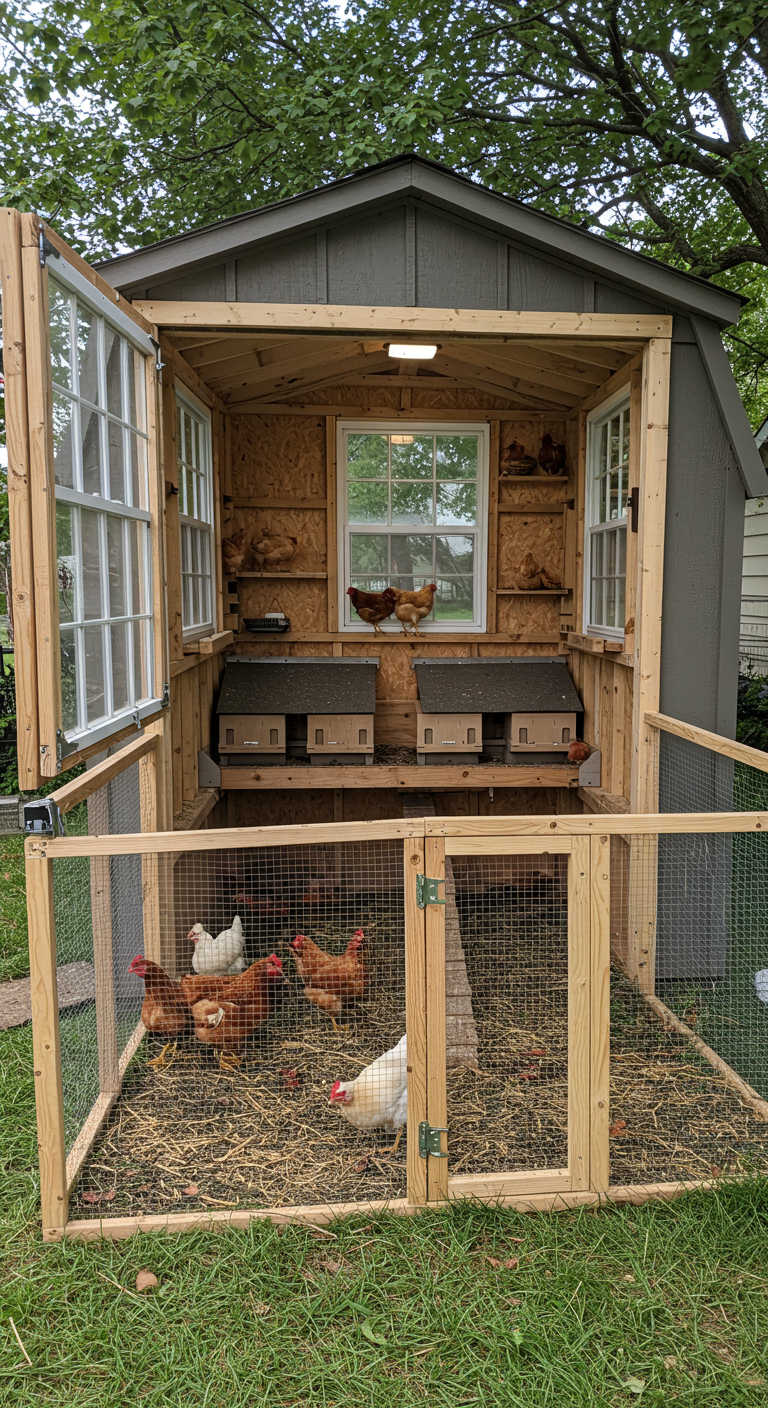
A revamped shed-turned-chicken coop, showing the addition of windows, nesting boxes, and an attached run.
Barn-Style Coops
For larger flocks, barn-style coops offer plenty of room. These coops often feature high ceilings for ventilation and multiple nesting boxes. Their spacious design makes cleaning and maintenance easier.
Greenhouse Coops
Combine practicality and sustainability with a greenhouse-style coop. This design offers warmth in the winter and space to grow plants or house chickens. It’s perfect for homesteaders looking to maximize functionality.
Mobile Coops (Chicken Tractors)
Portable coops allow chickens to graze on fresh grass daily, which improves soil health and reduces feed costs. Lightweight materials like PVC pipes or wood make moving these coops easy.
Visual Cue: Show an image or diagram of a chicken tractor in a backyard, highlighting its mobility and rotational grazing benefits.
DIY Chicken House Ideas: Simple and Easy Designs
A-Frame Chicken Houses
A-frames are compact, portable, and great for small flocks. Their triangular shape provides good ventilation and protection from the elements. These structures are easy to assemble with basic tools.
Pallet Coops
Recycled pallets make affordable, eco-friendly chicken houses. Use pallets for walls and floors, then add a slanted roof to keep out rain. Pallet coops can be customized with paint or repurposed windows.
Step-by-Step Guide:
- Gather 8-10 pallets and a few 2x4s for support.
- Secure pallets together to form walls.
- Attach a roof using corrugated metal or wood.
- Add a hinged door for easy access and install chicken wire for ventilation.
Tarp and PVC Coops
Lightweight and budget-friendly, PVC pipe frames covered with tarps are quick to set up. They’re ideal for small spaces or temporary housing.
Upcycled Furniture Coops
Get creative with old furniture! Dressers, cabinets, or even armoires can be transformed into quirky, functional chicken houses. Add roosting bars, nesting boxes, and a wire door for ventilation.
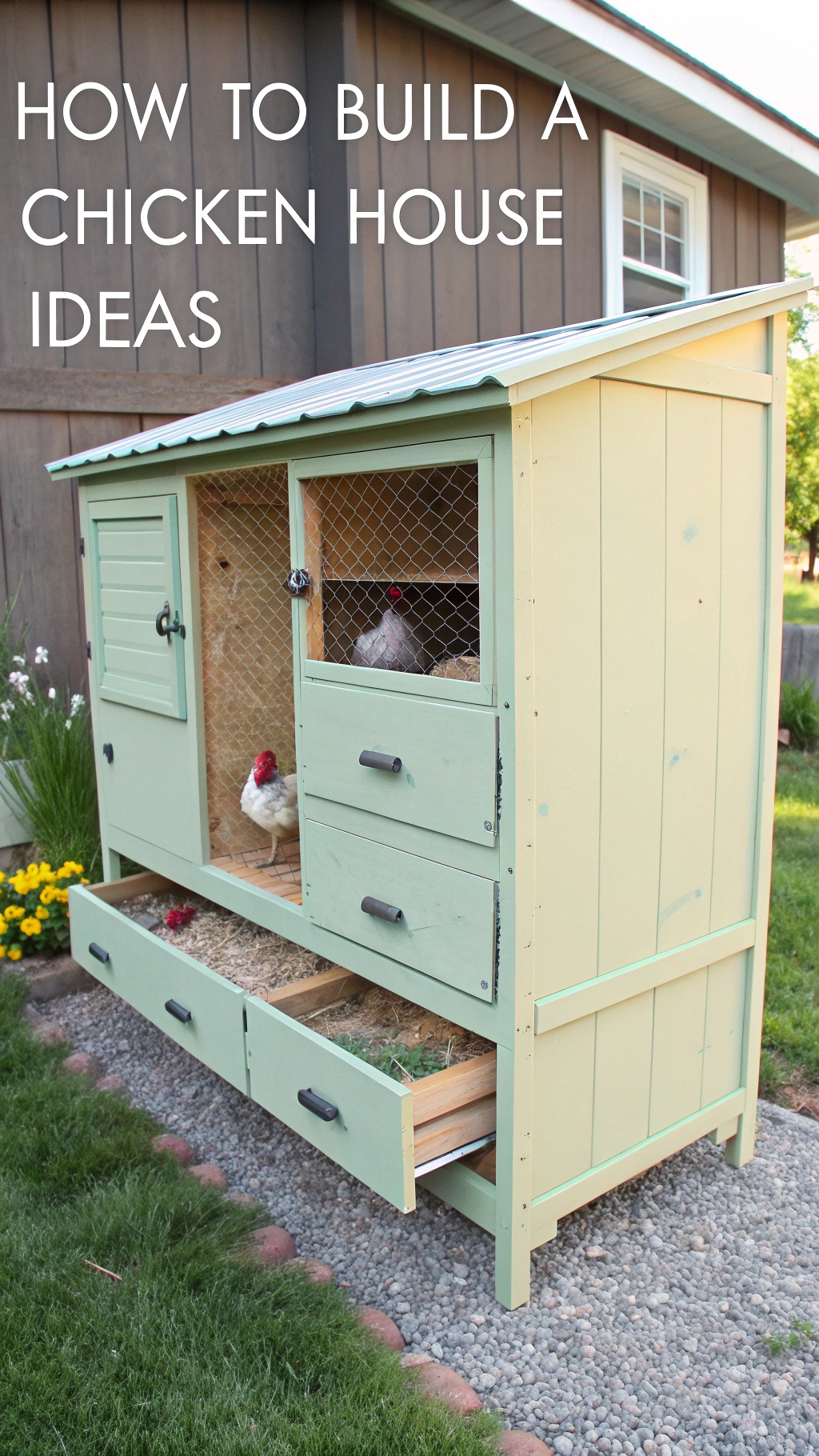
An upcycled furniture coop, such as a dresser repurposed with added chicken wire and nesting areas.
Chicken House Design Considerations
Ventilation and Insulation
Good airflow is essential for your chickens’ health. Poor ventilation can lead to ammonia buildup from droppings, which causes respiratory issues. Include vents near the roof or install windows that can open and close. Proper insulation is equally important, especially in extreme climates. Materials like foam boards or straw bales can help maintain a stable temperature inside the coop.
Nesting Boxes and Roosting Bars
Provide one nesting box for every 3-4 hens. These boxes should be placed off the ground and filled with soft bedding like straw or wood shavings. Roosting bars should be higher than the nesting boxes to encourage chickens to roost there at night. Aim for about 8 inches of bar space per bird to avoid overcrowding.
Predator-Proofing
Secure your coop with hardware cloth instead of chicken wire, as it’s more durable and keeps out predators. Bury the fencing 6-12 inches into the ground to prevent digging animals like foxes or raccoons. Add sturdy latches to doors and consider automatic closing mechanisms for extra security.
Easy Cleaning Features
Design your chicken house for convenience. Include removable trays for droppings, large access doors, and sloped floors for quick and easy cleaning. Elevated coops can also help prevent flooding and make maintenance easier.
Chicken House and Run Ideas
Integrated Runs
An attached run lets your chickens exercise and forage daily without exposing them to predators. Cover the run with a roof or netting for additional safety. Integrated runs are ideal for areas with limited free-range options.
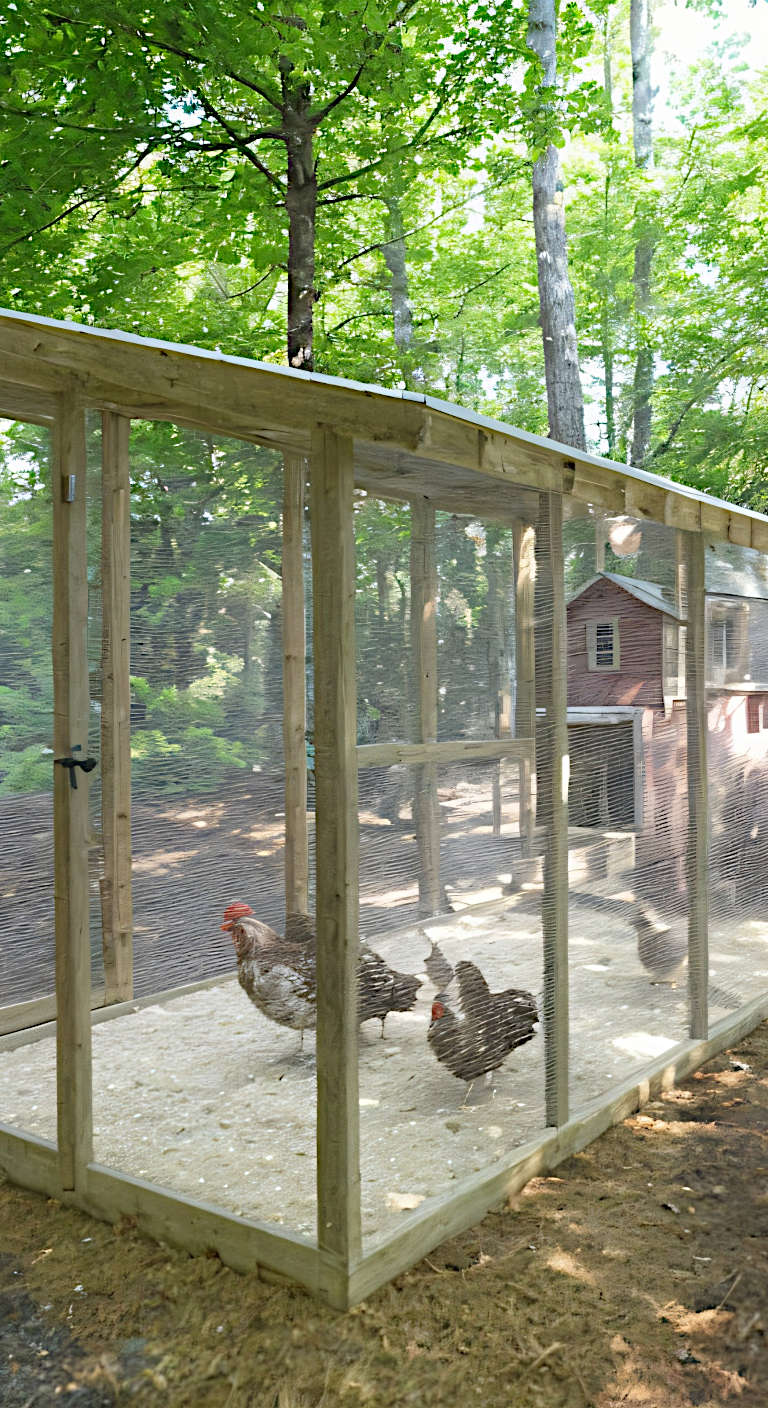
A chicken coop with an attached run, showing how it connects to the main house and the fencing used.
Free-Range Solutions
If you prefer free-ranging, consider fencing your yard or installing mobile fencing to create a safe roaming area. Training chickens to return to the coop at night is key to keeping them safe.
Enclosed Garden Runs
Combine your chicken run with a garden to create a productive, symbiotic setup. Chickens can forage for weeds and insects while fertilizing the soil. Protect plants with chicken wire or designate specific areas for foraging.
Visual Cue: Illustrate an enclosed garden run where chickens coexist with raised garden beds, emphasizing their role in weed and pest control.
Chicken House Accessory Ideas
Automatic Feeders and Waterers
Save time and reduce waste with automatic feeders and waterers. Gravity-fed systems or models with timers ensure your flock always has access to food and water. These accessories are especially helpful for busy homesteaders or when you’re away.
Solar Lighting
Adding solar-powered lights to your chicken house can extend daylight hours, which boosts egg production during shorter winter days. Solar lights are energy-efficient, easy to install, and don’t require wiring.
Dust Bath Areas
A designated dust bath area keeps your chickens clean and free from parasites. Fill a shallow container with a mix of sand, wood ash, and soil. Place it in a dry, sunny spot inside or near the coop for easy access.
Decorative Touches
Personalize your chicken house with fun additions like painted murals, vintage signs, or flower boxes. Not only does this make your coop a charming garden feature, but it also makes your backyard space more inviting
Duck House Ideas
Duck Housing
Ducks have different housing needs compared to chickens. They require more floor space, as they don’t roost like chickens do. Plan for at least 3-4 square feet per duck inside the house.
Duck-Specific Features
Ducks love water, so their housing should be near a water source or have a pond or shallow pool nearby. The flooring should be non-slippery, such as straw or sand, to prevent injuries. Ventilation is still crucial, but ducks are more tolerant of colder temperatures.
Separate but Adjacent Coops
If you’re keeping both chickens and ducks, consider building separate but nearby structures. Ducks are messier with water, and chickens prefer drier conditions, so dividing their housing ensures each species stays comfortable and healthy.
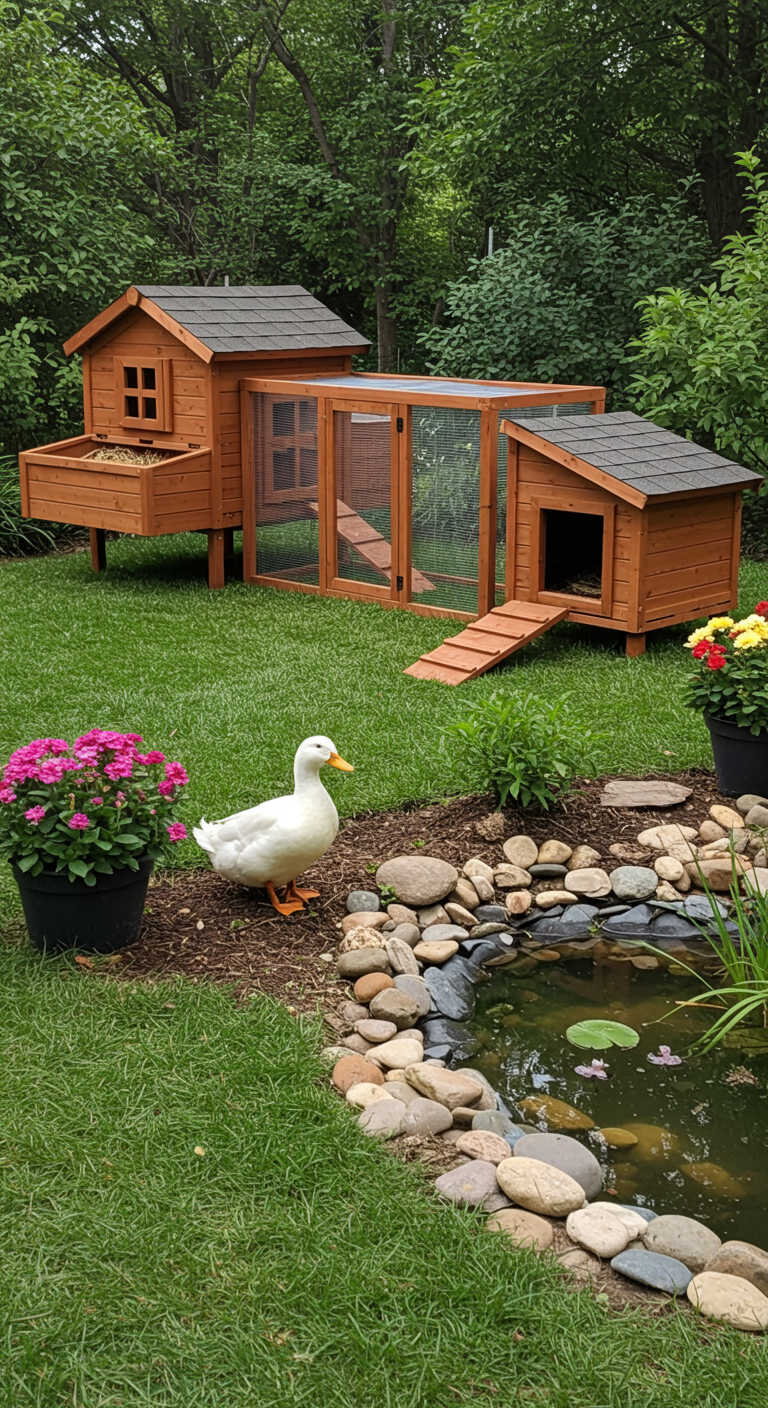
A chicken coop and a duck house side by side, highlighting their unique design features.
How to Build a Chicken House: Step-by-Step Guide
Planning and Materials
Start with a detailed plan, considering your flock size, climate, and available space. Make a checklist of materials, including wood, hardware cloth, screws, and roofing materials. Tools like a drill, saw, and measuring tape will also be essential.
Foundation and Framing
Choose a level site and clear debris. Build a sturdy foundation using concrete blocks, treated wood, or gravel. For framing, use 2×4 lumber to create a solid structure that can support walls and a roof.
Walls, Roof, and Flooring
Install walls using plywood or repurposed materials like pallets. A slanted roof helps with water drainage, and adding an overhang protects against rain. Use durable, easy-to-clean materials like linoleum or painted wood for the floor.
Finishing Touches
Add doors, windows, and ventilation features. Include nesting boxes, roosting bars, and an access door for cleaning. Finish with weatherproof paint or stain to protect the coop from the elements.
Budget-Friendly Chicken House Ideas
Low-Cost Materials
Reclaimed wood, scrap metal, and pallets are excellent choices for building an affordable chicken house. Check local classifieds or salvage yards for discounted or free materials.
Minimalist Designs
For a smaller flock, consider simple designs like A-frames or hoop coops. These require fewer materials and are quicker to assemble.
Community Resources
Join local farming or homesteading groups to find second-hand coops or leftover building supplies. Many communities have resources like tool-sharing programs to help reduce costs.
Tip: Hosting a coop-building party with friends or neighbors can save time and make the process more enjoyable.
Creative and Unique Chicken House Ideas
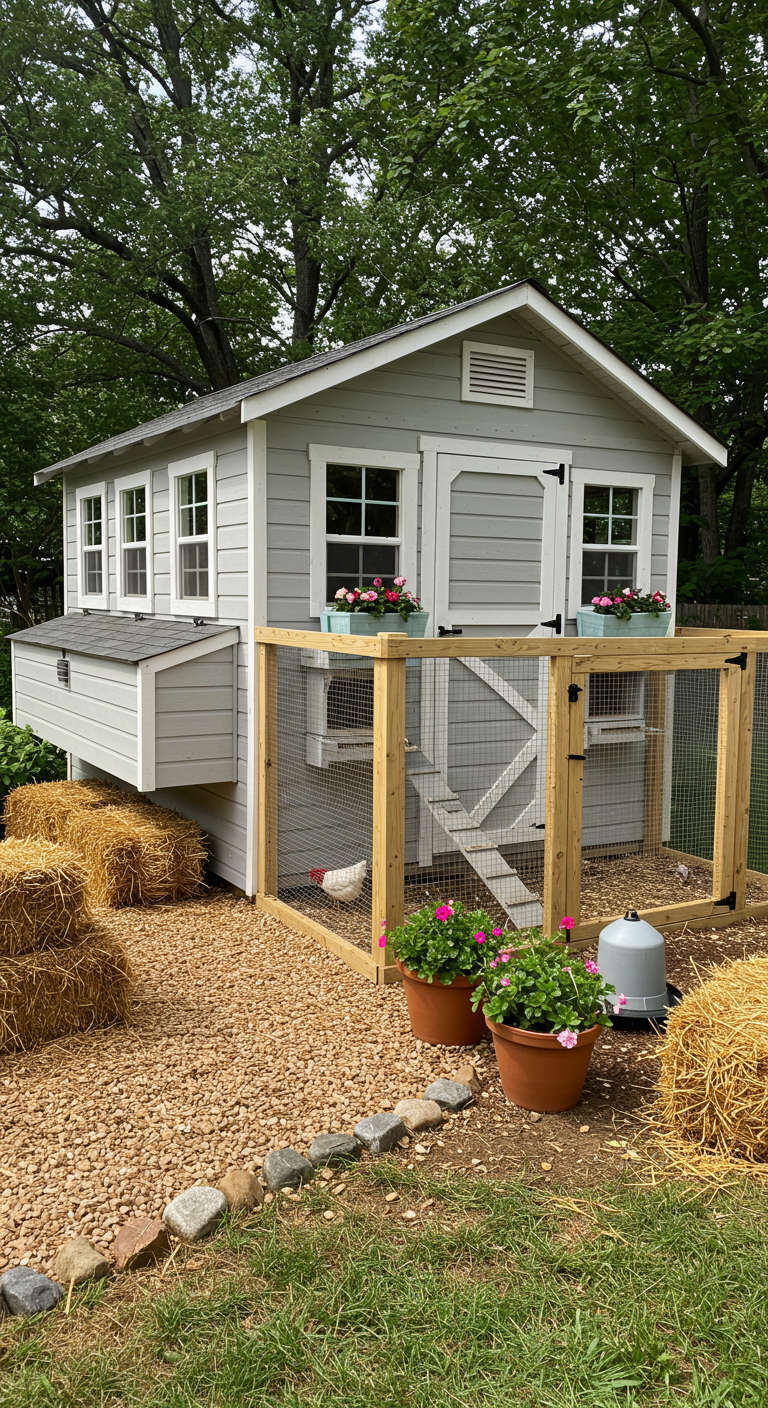
Themed Coops
Turn your chicken house into a centerpiece with a fun theme like a “Tiny Barn,” “Beach Hut,” or “Victorian Cottage.” Adding decorative shutters, a unique roof design, or a playful paint job can make your coop a visual delight while still functional.
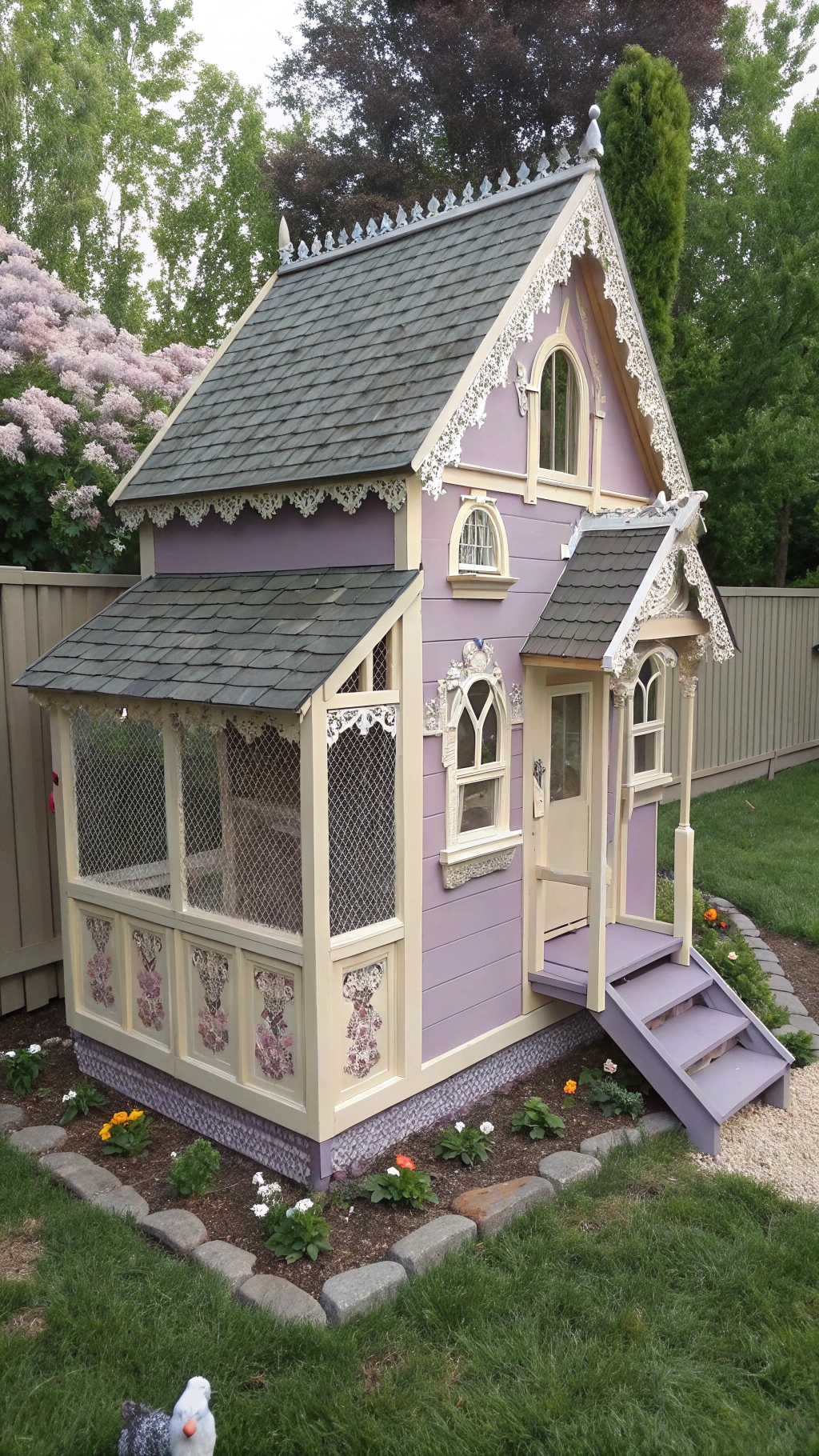
A Victorian cottage style coop
Vertical Coops
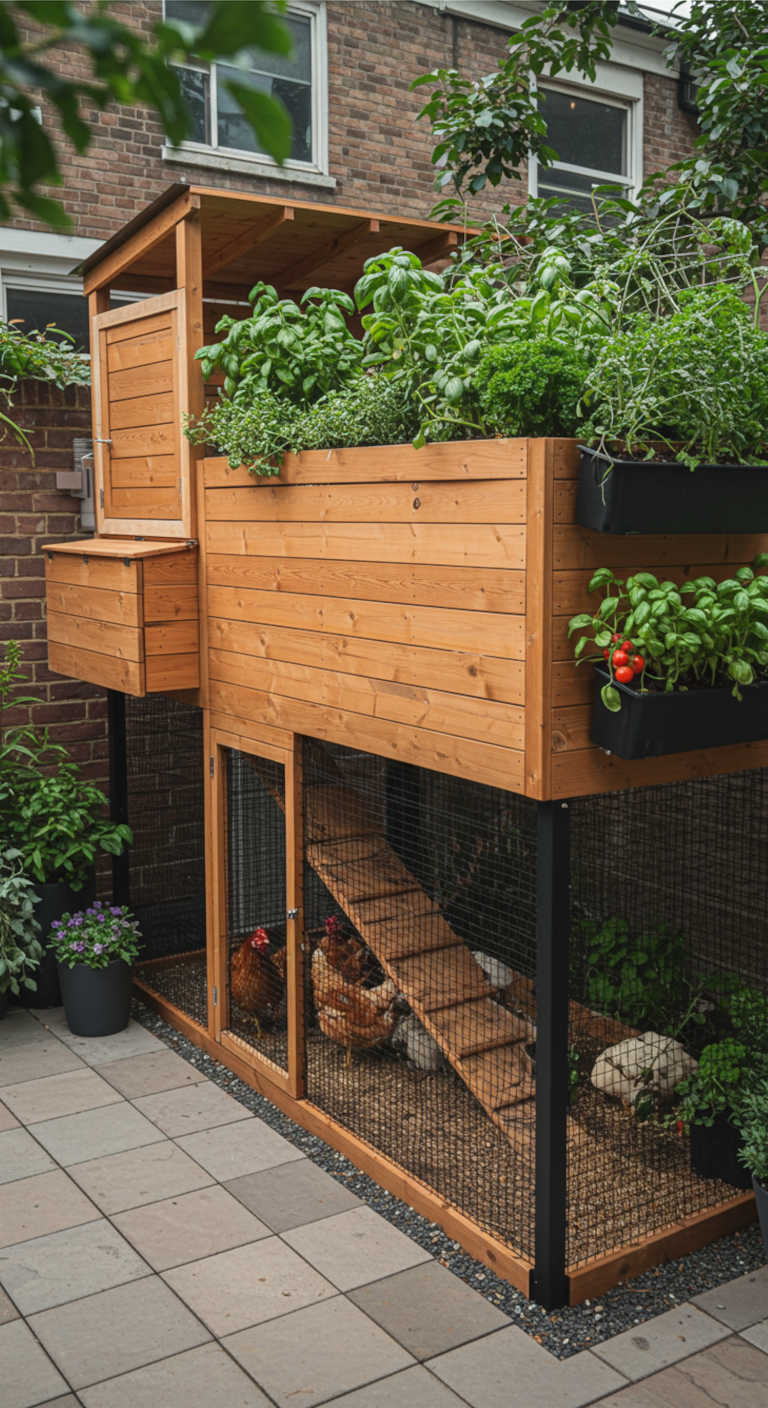
A modern vertical coop in a small urban backyard
Perfect for urban spaces, vertical coops maximize space by stacking the living area above the run. These coops are great for small backyards and can include rooftop gardens or storage underneath.
Artistic Coops
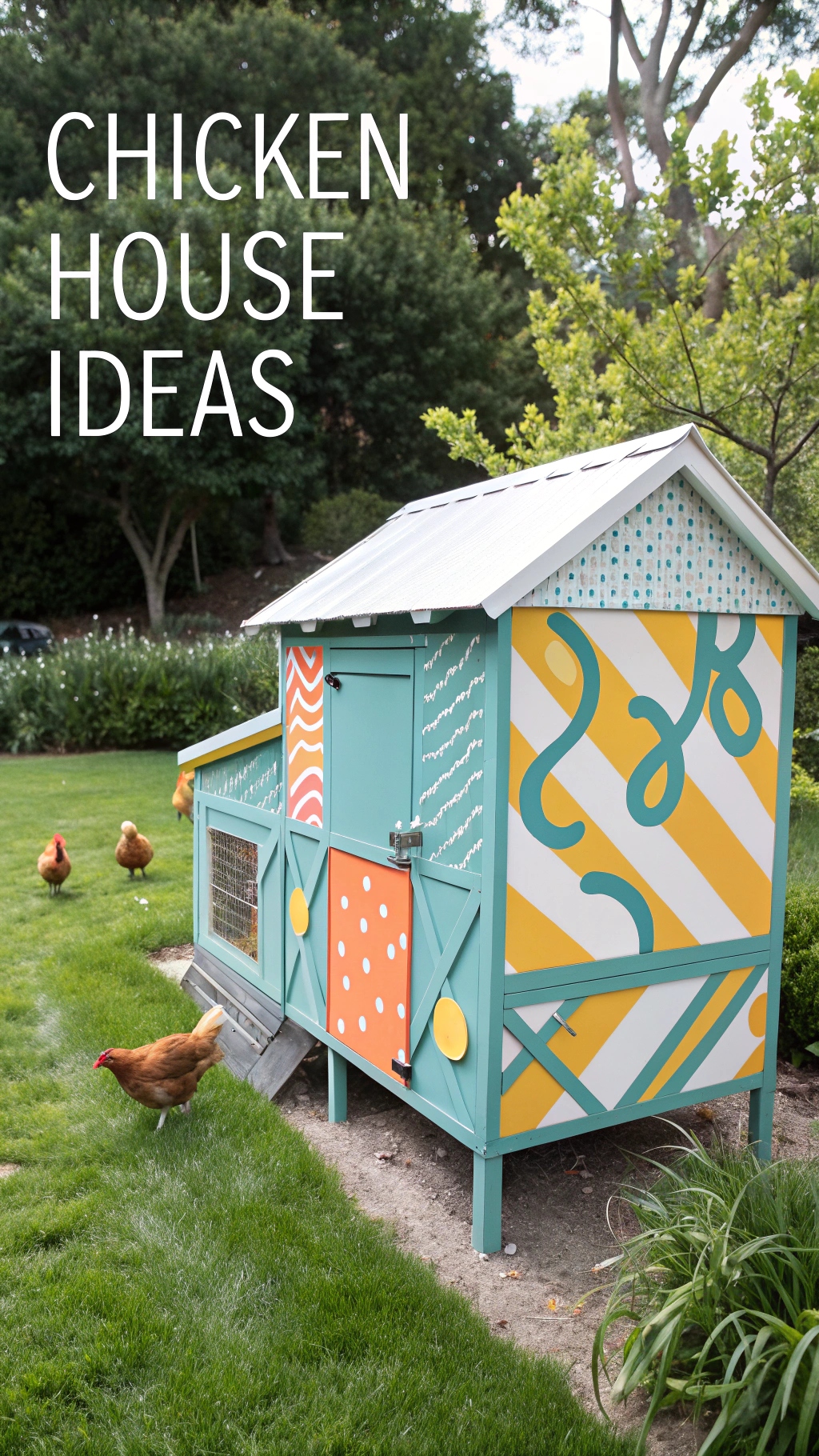
Blend art with function by designing a coop that doubles as yard art. Use bright colors, mosaic tiles, or creative shapes like a teapot or a train. These artistic coops can be a conversation starter and a whimsical addition to your yard.
Last Thoughts
A well-designed chicken house ensures your flock’s health, safety, and productivity while adding charm to your backyard. From repurposed structures to creative DIY designs, the possibilities are endless.
Start with a simple design that suits your flock size, then customize it with unique features and accessories. Building a chicken house can be a rewarding project that benefits both your chickens and your homestead. Whether you’re crafting a basic coop or an elaborate artistic masterpiece, the key is to have fun and tailor your design to your needs and creativity.
Your chickens will thank you with fresh eggs, happy clucks, and a thriving presence in your backyard!
